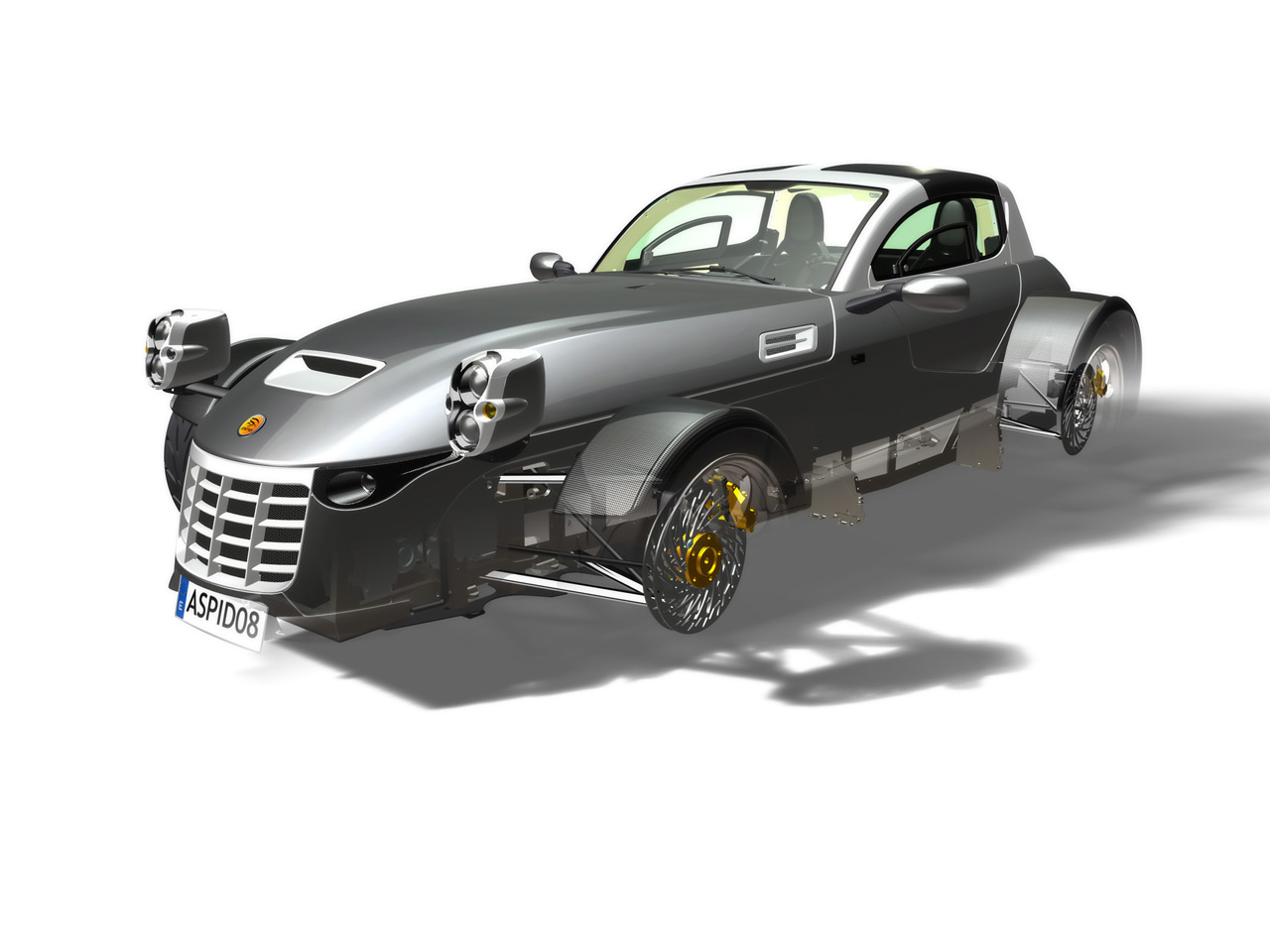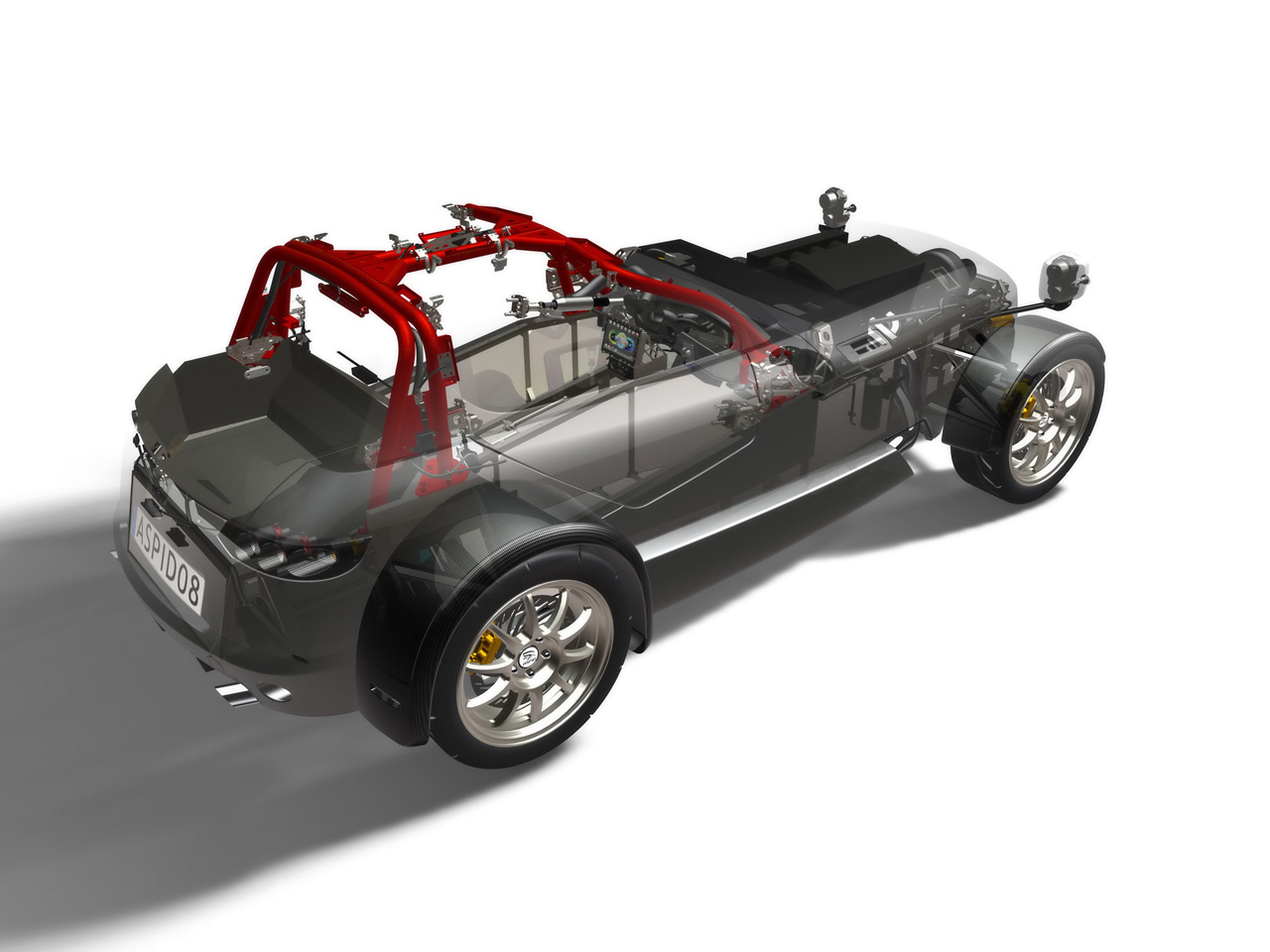2008 IFR Aspid
|
Price |
€95,000 |
Production |
-- | ||
|
Engine |
2 liter |
Weight |
1543 lbs | ||
|
Aspiration |
supercharger |
Torque |
-- | ||
|
HP |
400 hp |
HP/Weight |
3.9 lbs per hp | ||
|
HP/Liter |
200 hp per liter |
1/4 mile |
-- | ||
|
0-62 mph |
2.8 seconds |
Top Speed |
-- |
(from IFR Press
Release) Aspid’s stunning performance results from advanced
weight saving initiatives
Award-winning Spanish automotive design and technology company IFR
Automotive has revealed a wealth of weight, fuel and CO2 saving
technical innovations running throughout the chassis, suspension,
brakes and electrical systems of its new Aspid luxury sportscar
making its world debut at the British International Motor Show.
The Aspid’s 700kg kerb weight is minimal by any standard and less
than half the weight of a typical premium sportscar. With 400bhp
available from its 2-litre supercharged engine the virtually
unmatched power-to-weight ratio gives awesome acceleration with the
car reaching 62mph in 2.8 seconds and 100mph in 5.9 seconds.
The Aspid is also very compact - with a wheelbase smaller than a
city car - and cleverly packaged to accommodate even the tallest
driver and passenger. Despite its size, the fully enclosed
two-seater is comprehensively equipped and as far removed from being
a ‘stripped down to the bare essentials’ track-day special that you
could possibly imagine, which its performance figures would also
suggest. It is first and foremost a premium sportscar designed for
the road.
“The whole point of the Aspid is that it is small and lightning
fast, just like its namesake,” says company founder Ignacio
Fernández Rodriquez. “But we also believe it’s the first genuine
attempt at producing an unusually compact luxury sportscar, not just
with impeccable road holding and handling, but also with the highest
possible quality for a car of its size.”
“Our market research confirms the importance of a supercar having
strong emotional appeal. But it also has to be totally unique.
Combine these two factors with the need for robust environmental
credentials and the result is what we’ve endeavoured to achieve with
the Aspid.”
Looking at the bigger picture, Fernández believes all the technical
innovations the company has developed for the Aspid could be applied
to a wide range of vehicles including mass produced cars, thereby
making a relevant contribution to sustainable personal mobility.
Underpinning its massive weight saving is an ultra-lightweight
aluminium extrusion composite panelled chassis with a mass of just
75kg. The new and innovative construction method offers up to ten
times the torsional stiffness of a conventional un-panelled
space-frame and enhanced crash protection.
Similarly, the car’s major innovation in its suspension is an
ultra-lightweight aluminium extrusion, developed for the double
wishbone system, with a special profile that provides immense
stiffness and rigidity in all directions and minimises stresses
under torsional, longitudinal and vertical bending loads.
The Aspid also introduces an ultra-lightweight stainless steel brake
system comprised of thin twin discs each with turbine-shaped slots
for maximum air cooling and braking efficiency. The design results
in a low un-sprung mass and rotational inertia and a weight saving
of more than 70 per cent compared with normal brake systems.
IFR’s expertise in vehicle dynamics has allowed the company to
extract the maximum benefit from all this weight reduction, to
provide the driver with massively enhanced feedback through the
steering wheel, sublime handling and a superb grip of the road at
all times thanks to the excellent balance it has achieved by using
lightweight structures throughout the car.
The impressive weight saving, however, doesn’t end there. Aspid
features an all-new and fully-integrated electronic and electrical
system developed for the whole car. The company has reduced the
usual complexity of these systems by eliminating countless
components, assemblies and microprocessors.
The result is a significant reduction in the weight of electrical
systems and harnessing to around one-third that of current layouts
with a comparable reduction in the number of microprocessors to
about one for every four that would typically be specified in a
modern car. IFR has achieved this without compromising the myriad
tasks that need to be performed. In fact, the opposite is true and
the level of functionality has actually increased.
The most noticeable change for the driver is the elimination of
traditional instrumentation replaced by one or more interactive
touch screens. These allow the driver to change many parameters such
as the rev limit, valve timing, power output, steering assistance,
ABS, noise valve, brake balance, ride height, traction and stability
controls, as well as influencing the pitch, roll and yaw of the car
by adjusting its damping characteristics.
For motorsport enthusiasts the system offers an in-built and
extendable data logging capability, readily configured for all OBD
(onboard diagnostics) and CAN (control area network) sensors with 24
analogue channels available and upwards. For the road this is
complemented by GPS satellite navigation, GPRS/GSM mobile
communications, motion sensing accelerometers, Wi Fi wireless
technology, Ethernet interface connections, as well as touch screens
for both driver and co-driver.
The system can help reconfigure the car to suit different drivers
and different driving conditions and can ensure the Aspid is set-up
correctly for the road or track. It can even direct the driver
through a series of tests and operations that will enable it to
calculate engine torque and power.
“The result of all these technical innovations, careful choice of
materials and volumetric efficiency is a high level of performance
without compromising the ease with which the car can be driven on
normal roads,” says Fernández. “Its compact design makes the most
efficient use of the Aspid’s available space and the whole car is
extremely well packaged. Its low mass and significant weight
advantage also ensures excellent fuel economy and correspondingly
low CO2 emissions.”
The Aspid will be displayed throughout the motor show in the north
hall (stand N8A) of the ExCel exhibition centre. The show runs from
23 July to 3 August 2008.



